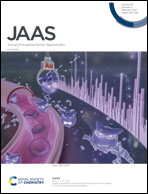The role of matrix in the evaluation of analytical parameters for trace determinations using TXRF spectrometry†
Abstract
The matrix plays a very crucial role in trace determinations, as it affects various analytical parameters if it is not properly evaluated. In the following study, the role of matrices, on the analytical parameters, were evaluated using MERCK ICP-multi elemental standard IV solutions diluted to varying concentrations from 0.1 μg mL−1 to 1000 μg mL−1 in dilute acid medium. The recovery rates and the relative standard deviations were evaluated to express the accuracy and the precision of the measured elemental concentrations. The recovery rate is the ratio of the experimentally and theoretically obtained analytical values of a concentration. The average relative standard deviations of the relative sensitivity values were within 7% for analyte concentrations within 20 μg mL−1 and within 12% for higher concentrations. The recovery rates were mostly negative (<100%) for the elements with concentrations above 50 μg mL−1, suggesting the evidence of matrix effect in these samples. In order to study the effects of different matrix elements (atomic number Z) on the evaluation of the analytical parameters, solutions of Al (Z = 13), Zr (Z = 40) and U (Z = 92) containing trace elements were also studied. In the case of Al, no significant matrix effect was observed irrespective of its concentration. However, in Zr and U, the matrix effect was negligible at 100 μg mL−1 concentration of the matrix, and evidence of significant matrix effects was observed in the samples with matrix concentrations of 1000 μg mL−1. The detection limits varied systematically with the analyte concentration, matrix concentration and matrix elements.



 Please wait while we load your content...
Please wait while we load your content...